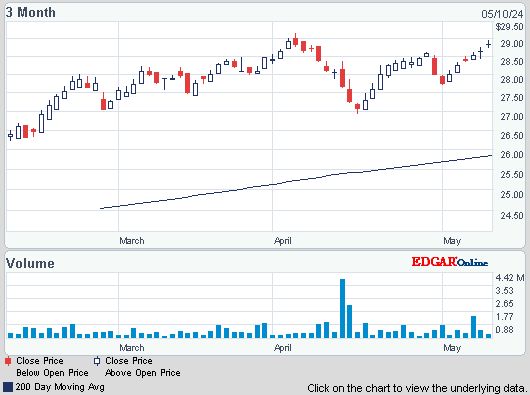After starting lower the Dow broke into the black & is up 34, but decliners just ahead of advancers 5-4 & NAZ gained 12. The MLP index fell 3+ to the 447s & the REIT index went up 2 to 245. Junk bond funds sold off & Treasuries are having another bad day. Oil rose to
a 5 week high after the American Petroleum Institute said
that crude stockpiles tumbled for the first time in 10 weeks. Gold gained on tapering concerns.
AMJ (Alerian MLP Index tracking fund)


Photo: Bloomberg
US private employers hired more workers than expected in Nov, suggesting the labor market was improving enough for the Federal Reserve to start trimming its bond purchases. The economic outlook was further brightened by other data showing a narrowing in the trade deficit in Oct as exports hit a record high. Private employers added 215K new jobs to their payrolls last month, according to the ADP National Employment Report, beating expectations for a gain of 173K jobs. The Oct gain was revised to 184K from 130K. The ADP data comes ahead of the gov much more comprehensive employment report for Nov on Fri, which includes both public & private sector hiring. That report is expected to show an increase of 180K in nonfarm payrolls, down from 204K in Oct. While the ADP report does not have a good track record predicting nonfarm payrolls, it raises the risk of a stronger reading on Fri.
Companies Boost U.S. Payrolls by Most in a Year
Purchases of new homes in the US surged in Oct by the most in 3 decades, signaling buyers are starting to take higher mortgage rates in stride. Sales jumped 25.4% to a 444K annualized rate, following a 354K rate in the prior month that was the weakest since Apr 2012, according to the Commerce Dept. The forecast called for 429K. Home sales are regaining strength as gains in employment & stock prices help consumers adjust to this year’s increase in borrowing costs & property values, which have hurt affordability. Builders are optimistic about the outlook for the market, which will need to expand to meet the needs of a growing population. Today’s report combined Oct & Sep data after the figures were delayed due to the gov shutdown. Purchases were down 6.6% in Sep from a 379K annualized pace in Aug that was weaker than the previously reported 421K. The revisions & Sep data indicate the market took a bigger hit than previously estimated following the increase in mortgage rates. The median sales price decreased 0.6% from Oct 2012 to $245K. Purchases rebounded in all 4 US regions, led by a 34% jump in the Midwest. The supply of homes dropped to 4.9 months from 6.4 months in the Sep which was the highest since Aug 2011. There were 183K new houses on the market at the end of Oct, down from 190K the prior month that was the most since Dec 2010.
Sales of New U.S. Homes Rose in October by Most in Three Decades
The US trade deficit narrowed in Oct for the first time in 4 months as exports climbed to a record. The gap decreased 5.4% to $40.6B from a $43B shortfall in Sep that was larger than previously estimated, according to the Commerce Dept. The forecast called for a $40B deficit. Sales of goods to China, Canada & Mexico were the highest ever, pointing to improving global demand that will benefit American manufacturers. In addition, an expanding US economy is helping boost growth abroad as purchases of products from the EU also climbed to a record in Oct even as fiscal gridlock prompted a federal shutdown. Exports climbed 1.8% to $192.7B on growing sales of food, petroleum products, drilling equipment & consumer goods, including jewelry. Companies are seeing the results of increased energy production in the US. The petroleum deficit shrank to $10.5B in Oct from $11B the prior month (after adjusting for inflation). Imports increased 0.4% to $233.3B in Oct, the most since Mar 2012. Gains in consumer goods such as toys & artwork, & fuel helped offset a slump in purchases of foreign automobiles. After eliminating the influence of prices, the trade deficit narrowed to $48.3B. That is little changed from the Q3 average of $48.7B, indicating trade is so far having minimal effect on Q4 GDP.
Trade Gap in U.S. Shrank in October on Record Exports
Stocks meander. The positive economic news would have brought more buyers in other times, but now it raises concerns about tapering. Any hint that the Federal Reserve will slow its bond buying program sends chills down the backs of bulls. As usual, the jobs report on Fri will be important for the markets even though it will likely give more of the same kind of data is has been doing all year. Dow is treading water, just under its lofty record levels. It's down 150 in Dec, sloshing around & looking for direction.
Dow Jones Industrials

AMJ (Alerian MLP Index tracking fund)
Treasury yields:
U.S. 3-month |
0.06% | |
U.S. 2-year |
0.29% | |
U.S. 10-year |
2.82% |
| CLF14.NYM | ...Crude Oil Jan 14 | ..............96.85 | (0.8%) |
| ZGZ13.CBT | .....Gold 100 oz. Dec 13 | ...1,238.50 | (1.4%) |

Photo: Bloomberg
US private employers hired more workers than expected in Nov, suggesting the labor market was improving enough for the Federal Reserve to start trimming its bond purchases. The economic outlook was further brightened by other data showing a narrowing in the trade deficit in Oct as exports hit a record high. Private employers added 215K new jobs to their payrolls last month, according to the ADP National Employment Report, beating expectations for a gain of 173K jobs. The Oct gain was revised to 184K from 130K. The ADP data comes ahead of the gov much more comprehensive employment report for Nov on Fri, which includes both public & private sector hiring. That report is expected to show an increase of 180K in nonfarm payrolls, down from 204K in Oct. While the ADP report does not have a good track record predicting nonfarm payrolls, it raises the risk of a stronger reading on Fri.
Companies Boost U.S. Payrolls by Most in a Year
Purchases of new homes in the US surged in Oct by the most in 3 decades, signaling buyers are starting to take higher mortgage rates in stride. Sales jumped 25.4% to a 444K annualized rate, following a 354K rate in the prior month that was the weakest since Apr 2012, according to the Commerce Dept. The forecast called for 429K. Home sales are regaining strength as gains in employment & stock prices help consumers adjust to this year’s increase in borrowing costs & property values, which have hurt affordability. Builders are optimistic about the outlook for the market, which will need to expand to meet the needs of a growing population. Today’s report combined Oct & Sep data after the figures were delayed due to the gov shutdown. Purchases were down 6.6% in Sep from a 379K annualized pace in Aug that was weaker than the previously reported 421K. The revisions & Sep data indicate the market took a bigger hit than previously estimated following the increase in mortgage rates. The median sales price decreased 0.6% from Oct 2012 to $245K. Purchases rebounded in all 4 US regions, led by a 34% jump in the Midwest. The supply of homes dropped to 4.9 months from 6.4 months in the Sep which was the highest since Aug 2011. There were 183K new houses on the market at the end of Oct, down from 190K the prior month that was the most since Dec 2010.
Sales of New U.S. Homes Rose in October by Most in Three Decades
The US trade deficit narrowed in Oct for the first time in 4 months as exports climbed to a record. The gap decreased 5.4% to $40.6B from a $43B shortfall in Sep that was larger than previously estimated, according to the Commerce Dept. The forecast called for a $40B deficit. Sales of goods to China, Canada & Mexico were the highest ever, pointing to improving global demand that will benefit American manufacturers. In addition, an expanding US economy is helping boost growth abroad as purchases of products from the EU also climbed to a record in Oct even as fiscal gridlock prompted a federal shutdown. Exports climbed 1.8% to $192.7B on growing sales of food, petroleum products, drilling equipment & consumer goods, including jewelry. Companies are seeing the results of increased energy production in the US. The petroleum deficit shrank to $10.5B in Oct from $11B the prior month (after adjusting for inflation). Imports increased 0.4% to $233.3B in Oct, the most since Mar 2012. Gains in consumer goods such as toys & artwork, & fuel helped offset a slump in purchases of foreign automobiles. After eliminating the influence of prices, the trade deficit narrowed to $48.3B. That is little changed from the Q3 average of $48.7B, indicating trade is so far having minimal effect on Q4 GDP.
Trade Gap in U.S. Shrank in October on Record Exports
Stocks meander. The positive economic news would have brought more buyers in other times, but now it raises concerns about tapering. Any hint that the Federal Reserve will slow its bond buying program sends chills down the backs of bulls. As usual, the jobs report on Fri will be important for the markets even though it will likely give more of the same kind of data is has been doing all year. Dow is treading water, just under its lofty record levels. It's down 150 in Dec, sloshing around & looking for direction.
Dow Jones Industrials










No comments:
Post a Comment